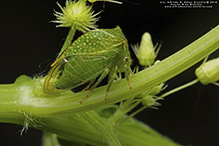typical treehoppers
(family Membracidae)
Overview • Description • Distribution • Taxonomy
Though called treehoppers, Membracidae occur on all types of vegetation. Most adults feed on the sap of trees or shrubs, but some feed on weeds or grasses, especially as nymphs. Many are host specific, feeding on plants in a single genus or family. Others are generalist feeders (polyphagous). Most are solitary but some are subsocial and appear in groups. The female has a saw-like ovipositor. She uses it to cut a slit in a twig and deposits an egg in the slit. The twig usually dies beyond that point. Adults and nymphs exude a sugary substance called honeydew, which could otherwise be infected with sooty molds. Ants, bees, and wasps feed on honeydew, and treehoppers are sometimes protected from predators by ants. |
||
Description |
||
Adults are small, usually ½″ (12 mm) or less in length. The exoskeletal plate covering the thorax (pronotum) is very long, extending back over the abdomen, and sometimes extending forward over the head, helmet-like. It is often expanded into an unusual shape. On some it is rounded, and the treehopper appears hump-backed. On some it projects upward and forward, looking like a plant thorn. On some it is spined, is keeled, or has a horn. The wings are held roof-like over the body when at rest. |
||
Distribution |
||||
|
Sources |
|||
| 1/27/2023 | ||||
Taxonomy |
|||
Order |
Hemiptera (True bugs, Hoppers, Aphids, and Allies) | ||
Suborder |
Auchenorrhyncha (true hoppers) | ||
Infraorder |
Cicadomorpha (spittlebugs, cicadas, leafhoppers and treehoppers) | ||
Superfamily |
Membracoidea (leafhoppers and treehoppers) | ||
Subordinate Taxa |
|||
Subfamily Centronodinae Subfamily Centrotinae Subfamily Darninae Subfamily Endoiastinae Subfamily Heteronotinae Subfamily Membracinae Subfamily Nicomiinae |
|||
Synonyms |
|||
|
|||
Common Names |
|||
treehoppers typical treehoppers |
|||
Glossary
Pronotum
The exoskeletal plate on the upper side of the first segment of the thorax of an insect.
Visitor Photos |
|||||
Share your photo of this insect. |
|||||
| This button not working for you? Simply email us at info@MinnesotaSeasons.com. Attach one or more photos and, if you like, a caption. |
|||||
|
|||||
MinnesotaSeasons.com Photos |
|||||
|
|||||

Slideshows |
||

Visitor Videos |
|||
Share your video of this insect. |
|||
| This button not working for you? Simply email us at info@MinnesotaSeasons.com. Attach a video, a YouTube link, or a cloud storage link. |
|||
Other Videos |
|||
| TreeHopper Thorn Bug Nature Stories |
|||
About
Dec 26, 2020 Treehoppers and thorn bugs are members of the family Membracidae, a group of insects related to the cicadas and the leafhoppers. About 3,200 species of treehoppers in over 400 genera are known. They are found on all continents except Antarctica; only five species are known from Europe. |
|||

Visitor Sightings |
|||||
Report a sighting of this insect. |
|||||
| This button not working for you? Simply email us at info@MinnesotaSeasons.com. Be sure to include a location. |
|||||
|
|
||||
MinnesotaSeasons.com Sightings |
|||||
|
|||||

Created: 1/27/2023
Last Updated:

